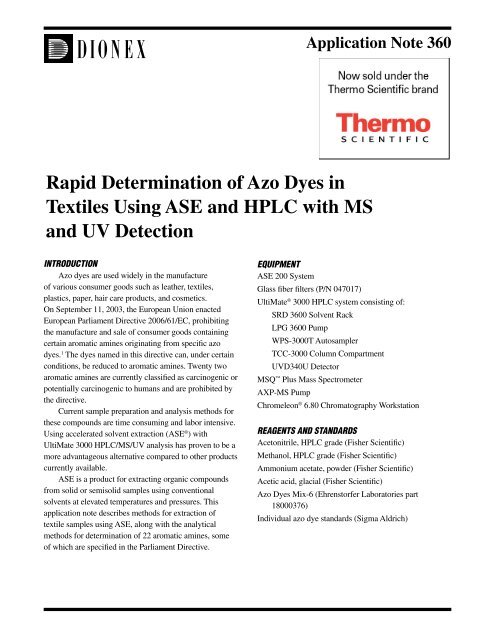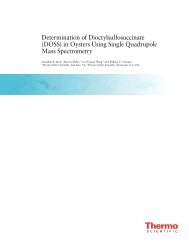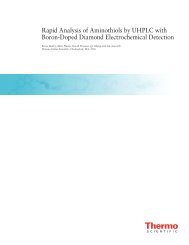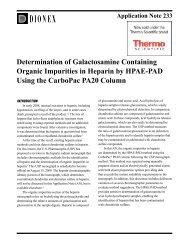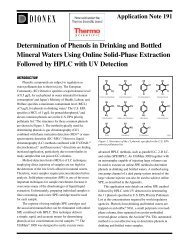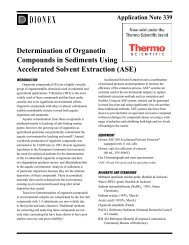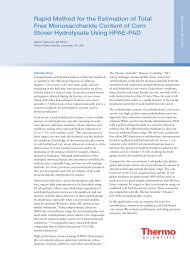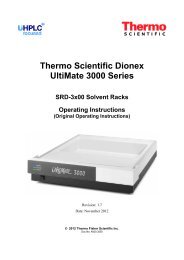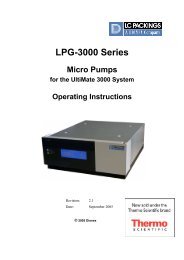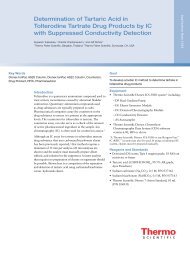AN 360: Rapid Determination of Azo Dyes in Textiles Using ... - Dionex
AN 360: Rapid Determination of Azo Dyes in Textiles Using ... - Dionex
AN 360: Rapid Determination of Azo Dyes in Textiles Using ... - Dionex
Create successful ePaper yourself
Turn your PDF publications into a flip-book with our unique Google optimized e-Paper software.
<strong>Rapid</strong> <strong>Determ<strong>in</strong>ation</strong> <strong>of</strong> <strong>Azo</strong> <strong>Dyes</strong> <strong>in</strong><br />
<strong>Textiles</strong> Us<strong>in</strong>g ASE and HPLC with MS<br />
and UV Detection<br />
IntroductIon<br />
<strong>Azo</strong> dyes are used widely <strong>in</strong> the manufacture<br />
<strong>of</strong> various consumer goods such as leather, textiles,<br />
plastics, paper, hair care products, and cosmetics.<br />
On September 11, 2003, the European Union enacted<br />
European Parliament Directive 2006/61/EC, prohibit<strong>in</strong>g<br />
the manufacture and sale <strong>of</strong> consumer goods conta<strong>in</strong><strong>in</strong>g<br />
certa<strong>in</strong> aromatic am<strong>in</strong>es orig<strong>in</strong>at<strong>in</strong>g from specific azo<br />
dyes. 1 The dyes named <strong>in</strong> this directive can, under certa<strong>in</strong><br />
conditions, be reduced to aromatic am<strong>in</strong>es. Twenty two<br />
aromatic am<strong>in</strong>es are currently classified as carc<strong>in</strong>ogenic or<br />
potentially carc<strong>in</strong>ogenic to humans and are prohibited by<br />
the directive.<br />
Current sample preparation and analysis methods for<br />
these compounds are time consum<strong>in</strong>g and labor <strong>in</strong>tensive.<br />
Us<strong>in</strong>g accelerated solvent extraction (ASE ® ) with<br />
UltiMate 3000 HPLC/MS/UV analysis has proven to be a<br />
more advantageous alternative compared to other products<br />
currently available.<br />
ASE is a product for extract<strong>in</strong>g organic compounds<br />
from solid or semisolid samples us<strong>in</strong>g conventional<br />
solvents at elevated temperatures and pressures. This<br />
application note describes methods for extraction <strong>of</strong><br />
textile samples us<strong>in</strong>g ASE, along with the analytical<br />
methods for determ<strong>in</strong>ation <strong>of</strong> 22 aromatic am<strong>in</strong>es, some<br />
<strong>of</strong> which are specified <strong>in</strong> the Parliament Directive.<br />
Application Note <strong>360</strong><br />
EquIpmEnt<br />
ASE 200 System<br />
Glass fiber filters (P/N 047017)<br />
UltiMate ® 3000 HPLC system consist<strong>in</strong>g <strong>of</strong>:<br />
SRD <strong>360</strong>0 Solvent Rack<br />
LPG <strong>360</strong>0 Pump<br />
WPS-3000T Autosampler<br />
TCC-3000 Column Compartment<br />
UVD340U Detector<br />
MSQ Plus Mass Spectrometer<br />
AXP-MS Pump<br />
Chromeleon ® 6.80 Chromatography Workstation<br />
rEagEnts and standards<br />
Acetonitrile, HPLC grade (Fisher Scientific)<br />
Methanol, HPLC grade (Fisher Scientific)<br />
Ammonium acetate, powder (Fisher Scientific)<br />
Acetic acid, glacial (Fisher Scientific)<br />
<strong>Azo</strong> <strong>Dyes</strong> Mix-6 (Ehrenstorfer Laboratories part<br />
18000376)<br />
Individual azo dye standards (Sigma Aldrich)
asE condItIons<br />
Preheat: 20 m<strong>in</strong> (purge closed)<br />
Pressure: 1500 psi<br />
Static Time: 5 m<strong>in</strong><br />
Temperature: 100 °C<br />
Cycles: 2<br />
Purge Time: 100 s<br />
Flush Volume: 30%<br />
Solvent: 90% MeOH with 10% 1 M KOH<br />
Extraction Time<br />
per Sample: 40 m<strong>in</strong><br />
Solvent Amount Used<br />
per Sample: 17 mL<br />
analytIcal condItIons<br />
Column: Acclaim ® 120 C18 3 µm 120 Å<br />
2.1 x 150 mm<br />
Eluent: H O/5%, CH CN/4%, CH OH<br />
2 3 3<br />
H O/40%, CH CN/45% CH OH<br />
2 3 3<br />
Column Temperature: 30 °C<br />
Flow Rate: 250 µL/m<strong>in</strong><br />
Injection Volume: 10 µL<br />
UV: 240 nm, 278 nm<br />
Ionization Mode: APCI, positive polarity<br />
Nitrogen: 3 bar<br />
Corona Current: 10 µA<br />
Source Temperature: 400 °C<br />
Cone Voltage: Varies by analyte (See Table 1.)<br />
SIM Mode: m/z by analyte (See Table 1.)<br />
Dwell Time: 0.3 s<br />
Span: 0.3 m/z<br />
Sample Prep<br />
Soak 1 g <strong>of</strong> material <strong>in</strong> 3 mL citrate buffer<br />
(pH 6.0) and 3 mL sodium dithionite (200 mg/mL) for<br />
2 m<strong>in</strong>. Transfer the mixture and solution to an ASE 11 mL<br />
cell conta<strong>in</strong><strong>in</strong>g a glass fiber filter.<br />
Extraction<br />
Place the extraction cells <strong>in</strong>to the ASE 200 carousel,<br />
and extract us<strong>in</strong>g the ASE conditions listed above. Record<br />
total volume <strong>of</strong> the extract, and <strong>in</strong>ject 10 µL onto the<br />
UltiMate 3000 HPLC/MS/UV system.<br />
LC Conditions<br />
Time Flow<br />
Rate<br />
(µL/m<strong>in</strong>)<br />
30 mM<br />
Ammonium<br />
Acetate, pH 4<br />
Acetonitrile Methanol Curve<br />
0.00 250 91 5 4<br />
25.00 250 69 27 4 5<br />
40.00 250 52 40 8 5<br />
45.00 250 15 40 45 5<br />
48.00 250 15 40 45 5<br />
48.10 250 91 5 4 5<br />
30 mM Ammonium Acetate, pH 4.0<br />
Weigh 2.31g NH OAc (FW 77.0825 g/mol). Add 1000<br />
4<br />
mL H O. Adjust pH to 4.0 with acetic acid.<br />
2<br />
2 <strong>Rapid</strong> <strong>Determ<strong>in</strong>ation</strong> <strong>of</strong> <strong>Azo</strong> <strong>Dyes</strong> <strong>in</strong> <strong>Textiles</strong> Us<strong>in</strong>g <strong>Dionex</strong> ASE and UltiMate 3000 HPLC Systems
Mass Spectrometer Conditions<br />
Individual standards for the azo dye compounds were<br />
obta<strong>in</strong>ed from Sigma Aldrich. An AXP-MS auxilliary<br />
pump was used to <strong>in</strong>fuse these samples for optimization<br />
<strong>in</strong> the mass spectrometer at a flow rate <strong>of</strong> 100 µL/<br />
m<strong>in</strong>. Dur<strong>in</strong>g the <strong>in</strong>fusions several scan funcions were<br />
performed to determ<strong>in</strong>e the optimum ionization technique,<br />
cone voltage, and and mass-to-charge ratio (m/z) for each<br />
analyte. These tuned values for cone voltage and m/z were<br />
used to def<strong>in</strong>e the SIM scans used <strong>in</strong> the method (Table 1).<br />
The preferred mode <strong>of</strong> ionization for all analytes<br />
was Atmospheric Pressure Chemical Ionizaion (APCI);<br />
positive mode. APCI is a gas-phase technique typically<br />
used to analyze small molecules. APCI is a robust<br />
technique which is not affected by m<strong>in</strong>or changes <strong>in</strong><br />
buffer strength. In positive ionization mode, protonated<br />
analyte ions are formed by gas-phase ion molecule<br />
reactions, result<strong>in</strong>g <strong>in</strong> the formation <strong>of</strong> [M+H] + ions.<br />
In some cases the SIM scans were staggered across<br />
the run time dur<strong>in</strong>g analysis; focus<strong>in</strong>g on a two m<strong>in</strong>ute<br />
region before and after the analyte eluted. Sequenc<strong>in</strong>g<br />
the scan functions <strong>in</strong> this fashion m<strong>in</strong>imized the total<br />
analytical cycle time and allowed the mass spectrometer<br />
to collect more data for the peaks <strong>of</strong> <strong>in</strong>terest, while<br />
exclud<strong>in</strong>g data collection where no signal was present.<br />
Table 1. Optimized Detection Conditions <strong>of</strong> <strong>Azo</strong> Dye<br />
Standards for Mass Spectrometric Analysis<br />
Compound Name Molecular<br />
Weight<br />
SIM<br />
m/z<br />
Cone<br />
Voltage (V)<br />
4-Am<strong>in</strong>oazobenzene 197.09 198 70<br />
2,4-Diam<strong>in</strong>otoluene 122.08 123 55<br />
4-Am<strong>in</strong>obiphenyl 169.09 170 30<br />
4,4’-Oxydianil<strong>in</strong>e 200.09 201 60<br />
2-Anisid<strong>in</strong>e 123.07 124 80<br />
4,4’-Methylenebis-(2-chloroanil<strong>in</strong>e) 266.04 267 50<br />
4,4’-Benzid<strong>in</strong>e 184.10 185 50<br />
o-Toluid<strong>in</strong>e 107.07 108 40<br />
4-Chloro-2-methylanil<strong>in</strong>e 141.03 142 60<br />
2-Methoxy-5-methylanil<strong>in</strong>e 137.08 138 55<br />
Bis-4-am<strong>in</strong>ophenylmethane 198.27 199 50<br />
4-Chloroanil<strong>in</strong>e 127.02 128 70<br />
o-Dianisid<strong>in</strong>e 244.12 245 55<br />
o-Tolid<strong>in</strong>e 212.13 213 55<br />
2-Am<strong>in</strong>onaphthalene 143.07 144 60<br />
2,6-Dimethylanil<strong>in</strong>e 121.09 122 55<br />
2,4-Dimethylanil<strong>in</strong>e 121.09 122 50<br />
4,4’-Methylenebis-(2-methylanil<strong>in</strong>e) 226.04 227 55<br />
3,3’-Dichlorobenzid<strong>in</strong>e 252.02 253 55<br />
2-Methyl-5-nitroanil<strong>in</strong>e 152.06 153 50<br />
4-Methoxy-1,3-phenylenediam<strong>in</strong>e 138.17 139 55<br />
4,4’-Thiodianil<strong>in</strong>e 216.30 217 50<br />
Application Note <strong>360</strong> 3
Column: Acclaim 120 C18 3 µm,<br />
120 Å (2.1 x 150 mm)<br />
Eluent: H2O/5% CH3CN/4% CH3OH<br />
H2O/40% CH3CN/45% CH3OH<br />
Temperature: 30 °C<br />
Peaks:<br />
1. 2,4-Diam<strong>in</strong>otoluene<br />
2. 4,4’-Oxydianil<strong>in</strong>e<br />
3. 2-Anisid<strong>in</strong>e<br />
4. 4,4’-Benzid<strong>in</strong>e<br />
5. 4-Methoxy-1,3-Phenylenediam<strong>in</strong>e<br />
6. o-Toluid<strong>in</strong>e<br />
7. Bis-4-am<strong>in</strong>ophenylmethane<br />
8. 2,4-Dimethylanil<strong>in</strong>e<br />
9. 2-Methoxy-5-methylanil<strong>in</strong>e<br />
10. 4-Cholroanil<strong>in</strong>e<br />
11. 2,6-Dimethylanil<strong>in</strong>e<br />
1 2 3<br />
4<br />
5 6 7 8<br />
9<br />
10<br />
11<br />
12 13<br />
Flow Rate: 250 µL/m<strong>in</strong><br />
Inj. Volume: 10 µL<br />
Detection: UV, 278 nm<br />
MSQ, APCI positive ionization<br />
12. o-Dianisid<strong>in</strong>e<br />
13. o-Tolid<strong>in</strong>e<br />
14. 2-Methyl-5-nitroanil<strong>in</strong>e<br />
15. 4,4’-Methylenebis-(2-methylanil<strong>in</strong>e)<br />
16. 2-Am<strong>in</strong>onapthal<strong>in</strong>e<br />
17. 4,4’-Thiodianil<strong>in</strong>e<br />
18. 4-Chloro-2-methylanil<strong>in</strong>e<br />
19. 4-Am<strong>in</strong>oazobenzene<br />
20. 3,3’-Dichlorobenzid<strong>in</strong>e<br />
21. 4-Am<strong>in</strong>obiphenyl<br />
22. 4,4’-Methylenebis-(2-chloroanil<strong>in</strong>e)<br />
0 10 20 30 40 45<br />
M<strong>in</strong>utes<br />
25331<br />
Figure 1. UV separation <strong>of</strong> azo dye standard mixture detected at<br />
278 nm.<br />
rEsults and dIscussIon<br />
A tertiary gradient was used because acetonitrile was<br />
found to improve the resolution <strong>of</strong> the peaks elut<strong>in</strong>g at<br />
the beg<strong>in</strong>n<strong>in</strong>g <strong>of</strong> the analysis, while methanol improved<br />
separation <strong>of</strong> the peaks at the end <strong>of</strong> the run. Ammonium<br />
acetate was used to ma<strong>in</strong>ta<strong>in</strong> a pH <strong>of</strong> 4, ensur<strong>in</strong>g analytes<br />
rema<strong>in</strong>ed <strong>in</strong> the the acid form; this resulted <strong>in</strong> improved<br />
detection by the mass spectrometer.<br />
Us<strong>in</strong>g the photodiode array detector, two<br />
wavelengths, 240 and 278nm, demonstrated optimum<br />
response for azo dye detection. Figures 1 and 2 show the<br />
detection and separation <strong>of</strong> the 22 aromatic am<strong>in</strong>es, each<br />
at a concentration <strong>of</strong> 5 mg/L.<br />
14<br />
16<br />
15<br />
17<br />
18<br />
19 20<br />
21<br />
22<br />
Column: Acclaim 120 C18 3 µm,<br />
120 Å (2.1 x 150 mm)<br />
Eluent: H2O/5% CH3CN/4% MeOH<br />
H2O/40% CH3CN/45% MeOH<br />
Temperature: 30 °C<br />
Peaks:<br />
1. 2,4-Diam<strong>in</strong>otoluene<br />
2. 4,4’-Oxydianil<strong>in</strong>e<br />
3. 2-Anisid<strong>in</strong>e<br />
4. 4,4’-Benzid<strong>in</strong>e<br />
5. 4-Methoxy-1,3-Phenylenediam<strong>in</strong>e<br />
6. o-Toluid<strong>in</strong>e<br />
7. Bis-4-am<strong>in</strong>ophenylmethane<br />
8. 2,4-Dimethylanil<strong>in</strong>e<br />
9. 2-Methoxy-5-methylanil<strong>in</strong>e<br />
10. 4-Cholroanil<strong>in</strong>e<br />
11. 2,6-Dimethylanil<strong>in</strong>e<br />
12. o-Dianisid<strong>in</strong>e<br />
13. o-Tolid<strong>in</strong>e<br />
14. 2-Methyl-5-nitroanil<strong>in</strong>e<br />
3<br />
3<br />
1 2 5 6<br />
16<br />
7 10<br />
17<br />
11<br />
14<br />
8 15 18<br />
9<br />
Flow Rate: 250 µL/m<strong>in</strong><br />
Inj. Volume: 10 µL<br />
Detection: UV: 240 nm, 278 nm<br />
MSQ, APCI positive ionization<br />
15. 4,4’-Methylenebis-(2-methylanil<strong>in</strong>e)<br />
16. 2-Am<strong>in</strong>onapthal<strong>in</strong>e<br />
17. 4,4’-Thiodianil<strong>in</strong>e<br />
18. 4-Chloro-2-methylanil<strong>in</strong>e<br />
19. 4-Am<strong>in</strong>oazobenzene<br />
20. 3,3’-Dichlorobenzid<strong>in</strong>e<br />
21. 4-Am<strong>in</strong>obiphenyl<br />
22. 4,4’-Methylenebis-(2-chloroanil<strong>in</strong>e)<br />
Figure 2. Comparison <strong>of</strong> azo dye standards detected by UV and<br />
mass spectrometric detection. The UV trace appears at the bottom<br />
and is expanded to show the detection <strong>of</strong> all compounds us<strong>in</strong>g<br />
SIM (selected ion monitor<strong>in</strong>g) channels <strong>in</strong> the mass spectrometer.<br />
4 <strong>Rapid</strong> <strong>Determ<strong>in</strong>ation</strong> <strong>of</strong> <strong>Azo</strong> <strong>Dyes</strong> <strong>in</strong> <strong>Textiles</strong> Us<strong>in</strong>g <strong>Dionex</strong> ASE and UltiMate 3000 HPLC Systems<br />
4<br />
12 13<br />
1<br />
6<br />
19<br />
8<br />
2<br />
4 14<br />
5<br />
15<br />
7<br />
16<br />
9<br />
10 22<br />
11<br />
12<br />
20<br />
21<br />
22<br />
19<br />
13<br />
17<br />
21<br />
18<br />
20<br />
25330
Figures 3 and 4 show LC/MS analysis <strong>of</strong> two<br />
different leather samples extracted us<strong>in</strong>g ASE and<br />
detected by UV/MS. As demostrated <strong>in</strong> these figures,<br />
complete resolution between peaks us<strong>in</strong>g UV detection<br />
is difficult <strong>in</strong> complex matrices. The specificity provided<br />
by mass spectrometry is critical for detection and<br />
positive identification <strong>of</strong> low level concentrations <strong>of</strong> azo<br />
compounds <strong>in</strong> these solutions<br />
conclusIons<br />
ASE comb<strong>in</strong>ed with the UltiMate 3000 HPLC system<br />
and MSQ Plus/UV detectors create a powerful tool for<br />
extraction and analysis <strong>of</strong> azo dyes. The ASE system is<br />
ideally suited for the extraction <strong>of</strong> the complex matrices<br />
analyzed here, provid<strong>in</strong>g significant sav<strong>in</strong>gs <strong>in</strong> time and<br />
solvent use compared to other techniques.<br />
The complexity <strong>of</strong> the sample extracts makes<br />
identification and quantitation <strong>of</strong> analytes difficult us<strong>in</strong>g<br />
UV detection alone. Coupl<strong>in</strong>g the HPLC system to the<br />
MSQ Plus detector provides improved specificity and<br />
selectivity for identification <strong>of</strong> compounds prohibited by<br />
the European Parliament Directive.<br />
Column: Acclaim 120 C18 3 µm,<br />
120 Å (2.1 x 150 mm)<br />
Eluent: H2O/5% CH3CN/4% CH3OH<br />
H2O/40% CH3CN/45% CH3OH<br />
Temperature: 30 °C<br />
18<br />
mAU<br />
0<br />
4,500<br />
Counts<br />
1<br />
2<br />
M<strong>in</strong>utes<br />
Flow Rate: 250 µL/m<strong>in</strong><br />
Inj. Volume: 10 µL<br />
Detection: UV, 278 nm<br />
Peaks: 1. 2-anisid<strong>in</strong>e<br />
2. o-toluid<strong>in</strong>e<br />
0<br />
0.2 2.5 5 7.5 10 12.5 1517.5 2022.5 2527.5 3032.5 3537.5 4042.5 45<br />
Figure 3. The top trace shows UV separation <strong>of</strong> an unknown red<br />
leather extract sample. Poor resolution between the peaks makes<br />
identification <strong>of</strong> azo dyes difficult. The bottom trace shows the<br />
advantage <strong>of</strong>fered by mass spectrometry; clear, positive identification<br />
<strong>of</strong> 2-anisid<strong>in</strong>e and o-toluid<strong>in</strong>e.<br />
Column: Acclaim 120 C18 3 µm,<br />
120 Å (2.1 x 150 mm)<br />
Eluent: H2O/5% CH3CN/4% MeOH<br />
H2O/40% CH3CN/45% MeOH<br />
Temperature: 30 °C<br />
18<br />
mAU<br />
0<br />
2,000<br />
Counts<br />
1<br />
M<strong>in</strong>utes<br />
Flow Rate: 250 µL/m<strong>in</strong><br />
Inj. Volume: 10 µL<br />
Detection: UV: 240 nm, 278 nm<br />
Peaks: 1. o-toluid<strong>in</strong>e<br />
2. 4-am<strong>in</strong>obiphenyl<br />
400<br />
0.2 2.5 5 7.5 10 12.5 15 17.5 20 22.5 25 27.5 3032.5 35 37.5 40 42.5 45<br />
Figure 4. Us<strong>in</strong>g a mass spectrometer provides positive identification<br />
<strong>of</strong> o-toluid<strong>in</strong>e and 4-am<strong>in</strong>obiphenyl extracted from a brown<br />
leather sample.<br />
25329<br />
25328<br />
Application Note <strong>360</strong> 5<br />
2
lIst <strong>of</strong> manufacturErs<br />
Ehrenstorfer EQ Laboratories<br />
530 Means Street Suite 120, Atlanta, GA 30318<br />
Tel: (404) 586-6828; www.ehrenstorfer.com<br />
Thermo Scientific Corp., a division <strong>of</strong><br />
ThermoFischer Scientific, Inc.<br />
81 Wyman St., Waltham, MA, 02545,<br />
Tel: (781) 622-1000; www.thermo.com<br />
Sigma-Aldrich<br />
3050 Spruce St., St. Louis, MO 63178;<br />
Tel: (800) 325-3010; www.sigmaaldrich.com<br />
Passion. Power. Productivity.<br />
<strong>Dionex</strong> Corporation<br />
1228 Titan Way<br />
P.O. Box <strong>360</strong>3<br />
Sunnyvale, CA<br />
94088-<strong>360</strong>3<br />
(408) 737-0700<br />
North America<br />
U.S. (847) 295-7500<br />
Canada (905) 844-9650<br />
South America<br />
Brazil (55) 11 3731 5140<br />
Europe<br />
Austria (43) 1 616 51 25 Benelux (31) 20 683 9768 (32) 3 353 4294<br />
Denmark (45) 36 36 90 90 France (33) 1 39 30 01 10 Germany (49) 6126 991 0<br />
Ireland (353) 1 644 0064 Italy (39) 02 51 62 1267 Switzerland (41) 62 205 9966<br />
United K<strong>in</strong>gdom (44) 1276 691722<br />
rEfErEncEs<br />
1. Puntener, A., Page, C. European Ban on Certa<strong>in</strong><br />
<strong>Azo</strong> <strong>Dyes</strong>. TFL Leather and Technology. 2004. 2:1–5<br />
Chromeleon, ASE, Ultimate, and Acclaim are registered trademarks <strong>of</strong> <strong>Dionex</strong> Corporation.<br />
MSQ Plus is a trademark <strong>of</strong> Thermo Fischer Scientific.<br />
Asia Pacific<br />
Australia (61) 2 9420 5233 Ch<strong>in</strong>a (852) 2428 3282 India (91) 22 2764 2735<br />
Japan (81) 6 6885 1213 Korea (82) 2 2653 2580 S<strong>in</strong>gapore (65) 6289 1190<br />
Taiwan (886) 2 8751 6655<br />
LPN 2007-01 PDF 06/08<br />
©2008 <strong>Dionex</strong> Corporation<br />
www.dionex.com


